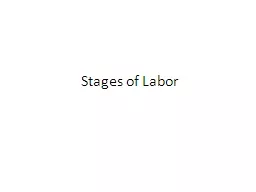

Lightening occurs pressure on upper abdomen is now reduced Early Signs bloody show losing your mucus plug Plug of mucus seals the cervix Before birth mucus begins to liquefy Woman may notice few drops of blood or pinkish staining ID: 912859
Download Presentation The PPT/PDF document "Stages of Labor The Beginning of Labor" is the property of its rightful owner. Permission is granted to download and print the materials on this web site for personal, non-commercial use only, and to display it on your personal computer provided you do not modify the materials and that you retain all copyright notices contained in the materials. By downloading content from our website, you accept the terms of this agreement.
Slide1
Stages of Labor
Slide2The Beginning of Labor
Lightening occurs
pressure on upper abdomen is now reduced
Slide3Early Signs
“bloody show”: losing your mucus plug
Plug of mucus seals the cervix
Before birth mucus begins to liquefy
Woman may notice few drops of blood or pinkish staining
Slide4Early Sign
“Her water broke”
Trickle or sometimes a gush of warm fluid from vagina
Membrane holding amniotic fluid has broken
When it breaks woman should note the time, amount of fluid and color/odor.
Once broken, baby normally delivered within 24-48 hours
Slide5Early Sign
Contractions: tightening and releasing of the muscle of the uterus
Uterus gets shorter and harder like any other muscle
Painful but bearable because of resting time
Slide6False Labor
If contractions are:
Not regular or rhythmic
Become increasingly stronger
Ending when woman walks
Contractions should be timed, how frequently they are occurring,
Slide7Stages of Labor
First Stage: contractions open cervix
Second Stage: baby is born
Third Stage: placenta is expelled
Slide8First Stage
Contractions prepare body for birth
Each time uterus contracts, muscles pull up on cervix thinning and opening it
Contractions get stronger and longer (60 seconds 5-6minutes apart)
As cervix opens, baby moves down into lower pelvis
“breech presentation”: feet or buttocks enter into pelvis first
Slide9First Stage
Transition=ending of first stage
Cervix is now fully dilated
Contractions even stronger, longer and more frequently
Most difficult part of labor
Slide10Second Stage
Crowning: top of head appears at the opening of birth canal
Head emerges: head has changed shape to fit through passage of birth canal, shoulders follow, then rest of baby
Slide11Equipment Used
Forceps: special surgical steel tongs that guides movement
Vacuum extraction: suction applied to babies head during contractions
Slide12Baby’s Body
Skull is soft and flexible
Consists of five separate bones that overlap to allow head to fit through pelvis and vagina
Slide13Mother’s Body
Pelvis
Bones are joined by ligaments that are very stretchy at the time of delivery
Helps pelvis stretch open
Vagina
stretchy
Relaxin
: hormone that makes this happy
Episiotomy: widen the vaginal opening with a surgical cut
Slide14Third Stage
After baby is born mother gets a short period of rest
Urge to push because of contractions
Very little discomfort
Placenta detaches from wall
Placenta is delivered
If placenta remains, bleeding or infection can occur
Slide15Cesarean Birth
Delivery of baby by making a surgical incision in the mother’s abdomen.
Mother and baby remain in hospital for 3 days
Some medications allow mother to remain awake during surgery
Slide16C-Section Incisions
Slide17Placenta Previa
Placenta grows in lowest part of uterus covering the cervix
The placenta can move as the uterus grows and stretches
Almost all women require a C-section to avoid severe bleeding
Can be fatal for mom and baby
Slide18Epidural
Most popular method of pain relief in labor
Epidurals block the nerve impulses from the lower spinal segments.
D
ecreased sensation in the lower half of the body.
Arch back, a needle then inserted into back, a small tube (catheter) is threaded through needle into back, needle removed, medicine injected.
Slide19Natural vs. Drugs
Natural:
unmedicated
approach to labor
Drugs: using medication as a pain reliever
Advantages and Disadvantages to both…?
Slide20Epidural
Natural
vs
drugs